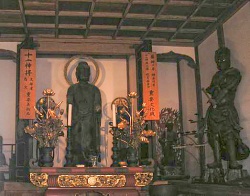Difference between revisions of "Twelve Heavenly Generals"
Jump to navigation
Jump to search
(Created page with "thumb|250px| In some Buddhist denominations, the Twelve Heavenly Generals or Twelve Divine Generals are the protective deities, or yaksha, of Bhaisa...") |
|||
| Line 1: | Line 1: | ||
[[File:Tijinoyakusi2.JPG|thumb|250px|]] | [[File:Tijinoyakusi2.JPG|thumb|250px|]] | ||
| − | In some Buddhist denominations, the Twelve Heavenly Generals or Twelve Divine Generals are the protective deities, or yaksha, of Bhaisajyaguru, the buddha of healing. They are introduced in the Bhaiṣajyaguruvaidūryaprabharāja Sūtra. | + | In some Buddhist denominations, the Twelve Heavenly Generals or Twelve Divine Generals are the protective deities, or yaksha, of Bhaisajyaguru, the buddha of healing. They are introduced in the Bhaiṣajyaguruvaidūryaprabharāja Sūtra. They are collectively named as follows: |
::*simplified Chinese: 十二神将; traditional Chinese: 十二神將; pinyin: Shí'èr Shén Jiāng | ::*simplified Chinese: 十二神将; traditional Chinese: 十二神將; pinyin: Shí'èr Shén Jiāng | ||
| − | ::*Japanese: Jūni Shinshō (十二神将?) or Jūni Shinnō (十二神王?) or Jūni Yakusha Taishō (十二薬叉大将?) | + | ::*Japanese: Jūni Shinshō (十二神将?) or Jūni Shinnō (十二神王?) or Jūni Yakusha Taishō (十二薬叉大将?) |
==Names of Generals== | ==Names of Generals== | ||
| − | The names of the generals are: | + | The names of the generals are: |
{| class="wikitable" | {| class="wikitable" | ||
|- | |- | ||
! Sanskrit !! kanji !! Hepburn romanization|romanized Japanese !! Pinyin | ! Sanskrit !! kanji !! Hepburn romanization|romanized Japanese !! Pinyin | ||
|- | |- | ||
| − | + | | Kumbhīra ||Nihongo2|宮毘羅<br>金毘羅 || Kubira<br>Kompira (Shinto) || ''Guānpíluò<br>Jīnpeíluò'' | |
|- | |- | ||
| − | + | | Vajra || Nihongo2|伐折羅 || Basara, Bazara || ''Fázhéluò'' | |
|- | |- | ||
| − | + | | Mihira || Nihongo2|迷企羅 || Mekira, Meikira || ''Míqǐluò'' | |
|- | |- | ||
| − | + | | Aṇḍīra || Nihongo2|安底羅 || Anchira, Anteira || ''Āndǐluò'' | |
|- | |- | ||
| − | + | | Anila || Nihongo2|頞儞羅 || Anira<br>Majira || ''Ènǐluò'' | |
|- | |- | ||
| − | + | |Sandilya (Rishi)|Śāṇḍilya || Nihongo2|珊底羅 || Sanchira, Santeira || ''Shāndìluò'' | |
|- | |- | ||
| − | + | | Indra}|| Nihongo2|因達羅<br>帝釈天 || Indara || ''Yīndàluò<br>Dìshìtiān'' | |
|- | |- | ||
| − | + | | Pajra || Nihongo2|波夷羅 || Haira || ''Bōyìluò'' | |
|- | |- | ||
| − | + | | Mahoraga || Nihongo2|摩虎羅<br>摩睺羅伽 || Makora<br>Makura || ''Mòhǔluò<br>Mòhóuluòjiā'' | |
|- | |- | ||
| − | + | | Kinnara || Nihongo2|真達羅 || Shintara, Kimnara<br>Shindūra || ''Zhēndàluò'' | |
|- | |- | ||
| − | + | | Catura || Nihongo2|招杜羅 || Shōtora<br>Shatora || ''Zhāodùluò'' | |
|- | |- | ||
| − | + | | Vikarāla || Nihongo2|毘羯羅 || Bikara<br>Bigyara || ''Píjiéluò'' | |
|} | |} | ||
| − | The goddess Marici (Buddhism)|Marichi, protector of warriors and protector against fire is sometimes worshipped as one of the Twelve Heavenly Generals. | + | The goddess Marici (Buddhism)|Marichi, protector of warriors and protector against fire is sometimes worshipped as one of the Twelve Heavenly Generals. |
==Popular culture== | ==Popular culture== | ||
Revision as of 16:18, 22 June 2013
In some Buddhist denominations, the Twelve Heavenly Generals or Twelve Divine Generals are the protective deities, or yaksha, of Bhaisajyaguru, the buddha of healing. They are introduced in the Bhaiṣajyaguruvaidūryaprabharāja Sūtra. They are collectively named as follows:
- simplified Chinese: 十二神将; traditional Chinese: 十二神將; pinyin: Shí'èr Shén Jiāng
- Japanese: Jūni Shinshō (十二神将?) or Jūni Shinnō (十二神王?) or Jūni Yakusha Taishō (十二薬叉大将?)
Names of Generals
The names of the generals are:
| Sanskrit | kanji | romanized Japanese | Pinyin |
|---|---|---|---|
| Kumbhīra | 宮毘羅 金毘羅 |
Kubira Kompira (Shinto) |
Guānpíluò Jīnpeíluò |
| Vajra | 伐折羅 | Basara, Bazara | Fázhéluò |
| Mihira | 迷企羅 | Mekira, Meikira | Míqǐluò |
| Aṇḍīra | 安底羅 | Anchira, Anteira | Āndǐluò |
| Anila | 頞儞羅 | Anira Majira |
Ènǐluò |
| Śāṇḍilya | 珊底羅 | Sanchira, Santeira | Shāndìluò |
| Indra} | 因達羅 帝釈天 |
Indara | Yīndàluò Dìshìtiān |
| Pajra | 波夷羅 | Haira | Bōyìluò |
| Mahoraga | 摩虎羅 摩睺羅伽 |
Makora Makura |
Mòhǔluò Mòhóuluòjiā |
| Kinnara | 真達羅 | Shintara, Kimnara Shindūra |
Zhēndàluò |
| Catura | 招杜羅 | Shōtora Shatora |
Zhāodùluò |
| Vikarāla | 毘羯羅 | Bikara Bigyara |
Píjiéluò |
The goddess Marici (Buddhism)|Marichi, protector of warriors and protector against fire is sometimes worshipped as one of the Twelve Heavenly Generals.
Popular culture
General Catura at Ngong Ping
- Statues of the Twelve Heavenly Generals stand in Ngong Ping, Hong Kong. They are near the Statue of Big Buddha.
- In the anime Digimon Tamers, the twelve devas are named after the Twelve Heavenly Generals.
